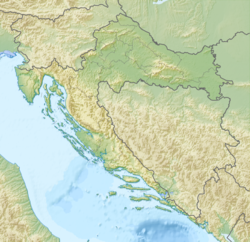Split
Spalato | |
|---|---|
| Grad Split City of Split | |
Bačvice Beach View of city at night | |
|
| |
| Nickname: Velo misto ('[The] big town') | |
| Anthem: Marjane, Marjane | |
| Coordinates: 43°30′36″N 16°26′24″E / 43.51000°N 16.44000°E | |
| Country | Croatia |
| County | Split-Dalmatia |
| Founded as Aspálathos | 3rd or 2nd century BCE |
| Diocletian's Palace built | 305 CE |
| Diocletian's Palace settled | 639 CE |
| Government | |
| • Type | Mayor-Council |
| • Mayor | Ivica Puljak (Centre) |
| • City Council | 31 members[1] |
| • Electoral district | 10th |
| Area | |
| • City | 79.4 km2 (30.7 sq mi) |
| • Urban | 23.1 km2 (8.9 sq mi) |
| Elevation | 0 m (0 ft) |
| Population (2021)[3] | |
| • City | 160,577 |
| • Density | 2,000/km2 (5,200/sq mi) |
| • Urban | 149,830 |
| • Urban density | 6,500/km2 (17,000/sq mi) |
| Time zone | UTC+1 (CET) |
| • Summer (DST) | UTC+2 (CEST) |
| Postal code | HR-21 000 |
| Area code | +385 21 |
| Vehicle registration | ST |
| Patron saint | Saint Domnius |
| Website | split |
| Official name | Historical Complex of Split with the Palace of Diocletian |
| Criteria | Cultural: (ii)(iii)(iv) |
| Reference | 97 |
| Inscription | 1979 (3rd Session) |
| Area | 20.8 ha (51 acres) |
Split (/splɪt/,[4][5] Croatian: [splît] ), historically known as Spalato[6] (Italian: [ˈspaːlato]; Venetian: Spàlato; see other names), is the second-largest city of Croatia, after the capital Zagreb, the largest city in Dalmatia and the largest city on the Croatian coast. It lies on the eastern shore of the Adriatic Sea and is spread over a central peninsula and its surroundings. An intraregional transport hub and popular tourist destination, the city is linked to the Adriatic islands and the Apennine Peninsula. More than 900,000 tourists visit it each year.[7]
The city was founded as the Greek colony of Aspálathos (‹See Tfd›Greek: Ἀσπάλαθος) in the 3rd or 2nd century BCE on the coast of the Illyrian Dalmatae, and in 305 CE, it became the site of the Palace of the Roman emperor Diocletian. It became a prominent settlement around 650 when it succeeded the ancient capital of the Roman province of Dalmatia, Salona. After the sack of Salona by the Avars and Slavs, the fortified Palace of Diocletian was settled by Roman refugees. Split became a Byzantine city. Later it drifted into the sphere of the Republic of Venice and the Kingdom of Croatia, with the Byzantines retaining nominal suzerainty. For much of the High and Late Middle Ages, Split enjoyed autonomy as a free city of the Dalmatian city-states, caught in the middle of a struggle between Venice and Croatia for control over the Dalmatian cities.
Venice eventually prevailed and during the early modern period Split remained a Venetian city, a heavily fortified outpost surrounded by Ottoman territory. Its hinterland was won from the Ottomans in the Morean War of 1699, and in 1797, as Venice fell to Napoleon, the Treaty of Campo Formio rendered the city to the Habsburg monarchy. In 1805, the Peace of Pressburg added it to the Napoleonic Kingdom of Italy and in 1806 it was included in the French Empire, becoming part of the Illyrian Provinces in 1809. After being occupied in 1813, it was eventually granted to the Austrian Empire following the Congress of Vienna, where the city remained a part of the Austrian Kingdom of Dalmatia until the fall of Austria-Hungary in 1918 and the formation of Yugoslavia. In World War II, the city was annexed by Italy, then liberated by the Partisans after the Italian capitulation in 1943. It was then re-occupied by Germany, which granted it to its puppet Independent State of Croatia. The city was liberated again by the Partisans in 1944, and was included in the post-war Socialist Yugoslavia, as part of its republic of Croatia. In 1991, Croatia seceded from Yugoslavia amid the Croatian War of Independence.
- ^ "Sastav Gradskog vijeća". split.hr. City of Split. Retrieved 8 April 2024.
- ^ Register of spatial units of the State Geodetic Administration of the Republic of Croatia. Wikidata Q119585703.
- ^ "Population by Age and Sex, by Settlements" (xlsx). Census of Population, Households and Dwellings in 2021. Zagreb: Croatian Bureau of Statistics. 2022.
- ^ Wells, John C. (2008). Longman Pronunciation Dictionary (3rd ed.). Longman. ISBN 978-1-4058-8118-0.
- ^ Roach, Peter (2011). Cambridge English Pronouncing Dictionary (18th ed.). Cambridge: Cambridge University Press. ISBN 978-0-521-15253-2.
- ^ Circulars - Volume 2. Johns Hopkins University. 1883. p. 32.
- ^ "Split Tourist Visits in 2019". Split.gg. 16 January 2020. Retrieved 17 November 2023.











